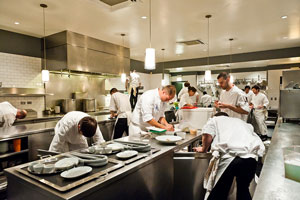Restaurants use a lot of energy. In the US, restaurants have one of the highest energy consumptions of any type of commercial building. There are a number of different factors associated with the high use and they all contribute to expensive bills at the end of the month. Because of this restaurant owners are constantly seeking for ways to make their establishment more energy efficient. All sorts of energy saving tactics have been used from adding windows to cut down on lighting costs to implementing policies that keep refrigerator doors closed but one area is overlooked. A restaurant’s ventilation system uses a significant amount of energy and more often than not can be altered to follow best practices and lead to big savings.

Kitchen ventilation is a necessity for almost all types of restaurants. A ventilation system will suck air coming off the grill out of a restaurant kitchen and replace it with fresh air from outdoors. This is essential for keeping a restaurant clean because it will keep any greasy, odorous air from your grill from getting into your establishment. A clean workplace will make sure that your employees can be as productive as possible. The clean air will also ensure that customers will be comfortable in your dining area and far more likely to return. Adequate ventilation also significantly lowers the risk that your establishment will experience a restaurant fire.
In order to have your ventilation running efficiently the first step is to make sure that you have the right type of hood. There are back shelf, wall-mounted canopy and single-island canopy hoods that each have specific attributes that can make them the right choice for your restaurant. In most cases there will be a hood that is prefabricated to meet the needs of your restaurant but additional energy savings can be found with a custom ventilation system.
After you have found the right type of hood for your establishment the next step is to make sure your kitchen is laid out in a way to optimize the hood’s use. All cooking equipment that produces air being sucked into the ventilation should be grouped together and pushed up against the wall. Any open space between the equipment and the ventilation system will make the system work harder and increase costs. A restaurant should also get the hood and ductwork regularly cleaned keep the risk of fire low and maximize efficiency.
Having a properly working ventilation system will help reduce the costs of running a restaurant and ensure it is an enjoyable place to be. Customers are far more likely to return to and recommend a restaurant they felt was clean. Get your restaurant’s ventilation working better while saving you money by calling CS Ventilation today.
 CS Ventilation | Commercial Kitchen Hood Cleaning
CS Ventilation | Commercial Kitchen Hood Cleaning